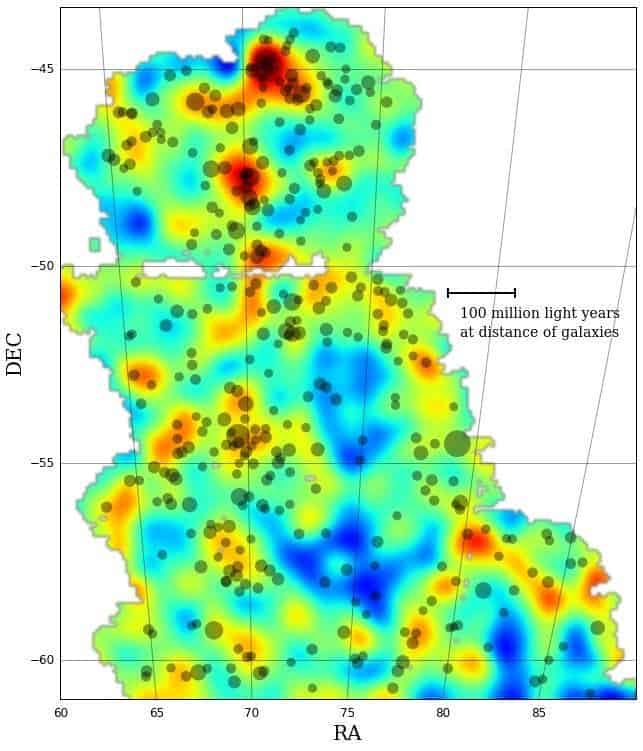This is the first map in a series of maps that will be stitched together to form a grand picture of how dark matter is distributed across the Universe. Dark matter is basically invisible, which is why it’s called dark in the first place, so scientists rely on indirect observations like the gravitational effects it poses to locate and map it. What we’re seeing now is only 3% of the area of sky that the Dark Energy Survey (DES) will document over its slated five-year-long mission.

The map traces the distribution of dark matter across a portion of the sky. The color scale represents projected mass density: red and yellow represent regions with more dense matter. Image: Dark Energy Survey
The map was created using one of the world’s most powerful digital cameras, the Dark Energy Camera, a 570-megapixel imaging device mounted on the 4-meter Victor M. Blanco telescope at the Cerro Tololo Inter-American Observatory in Chile. The image processing was handled the National Center for Supercomputing Applications at the University of Illinois in Urbana-Champaign.
Because it doesn’t emit or absorb light, dark matter is virtually invisible to our direct astronomical observations. Despite being so elusive, it accounts however for roughly a quarter of all the substances in the universe. There’s a trick though. By studying gravitational lensing – the distortion that occurs when the gravitational pull of dark matter bends light around distant galaxies – scientists can basically infer where dark matter hot spots are located and map them. This is useful since we can now compare dark matter with visible matter, and test models and cosmological theories. One such theory suggests, for instance, that galaxies form where there’s a greater concentration of dark matter, and hence stronger gravity.
“We measured the barely perceptible distortions in the shapes of about 2 million galaxies to construct these new maps,” said Vinu Vikram of Argonne National Laboratory. “They are a testament not only to the sensitivity of the Dark Energy Camera, but also to the rigorous work by our lensing team to understand its sensitivity so well that we can get exacting results from it.”
Preliminary DES data, like this map, lends credence to the idea of galaxies forming around dark matter clusters. Large filaments of matter along which visible galaxies and galaxy clusters lie and cosmic voids where very few galaxies reside, but only follow-up studies that will probe deeper and in more details will be able to tell us more.
“Our analysis so far is in line with what the current picture of the universe predicts,” said Chihway Chang, another of the lead scientists who is with ETH Zurich. “Zooming into the maps, we have measured how dark matter envelops galaxies of different types and how together they evolve over cosmic time. We are eager to use the new data coming in to make much stricter tests of theoretical models.”









